Tuesday, December 11, 2007
Adaptations and Biological of Reptiles
Green Sea Turtles:..-->Chelonia mydas, commonly known as the green turtle is a large sea turtle belonging to the family Cheloniidae. It is the only species in the genus Chelonia. The range of the species extends throughout tropical and subtropical seas around the world, with two distinct populations in the Atlantic and Pacific Oceans. Anatomically, there are a few characteristics that distinguish the green turtle from the other members of its family. Unlike the closely-related hawksbill turtle, the green turtle's snout is very short and its beak is unhooked. The horny sheath of the turtle's upper jaw possesses a slightly-denticulated edge while its lower jaw has stronger, serrated, more defined denticulation. The dorsal surface of the turtle's head has a single pair of prefrontal scales. Its carapace is composed of five central scutes flanked by four pairs of lateral scutes. Underneath, the green turtle has four pairs of infra-marginal scutes covering the area between the turtle's plastron and its shell. Mature C. mydas front appendages have only a single claw (as opposed to the hawksbill's two), although a second claw is sometimes prominent in young specimens.http://en.wikipedia.org/wiki/Green_sea_turtle#Anatomy_and_morphology~Describe at least 4 adaptations for each animal and contrast these adaptations to animals of the same class on land. How is the physiology different between the animal and another from the same class on land?
Subscribe to:
Post Comments (Atom)


No comments:
Post a Comment